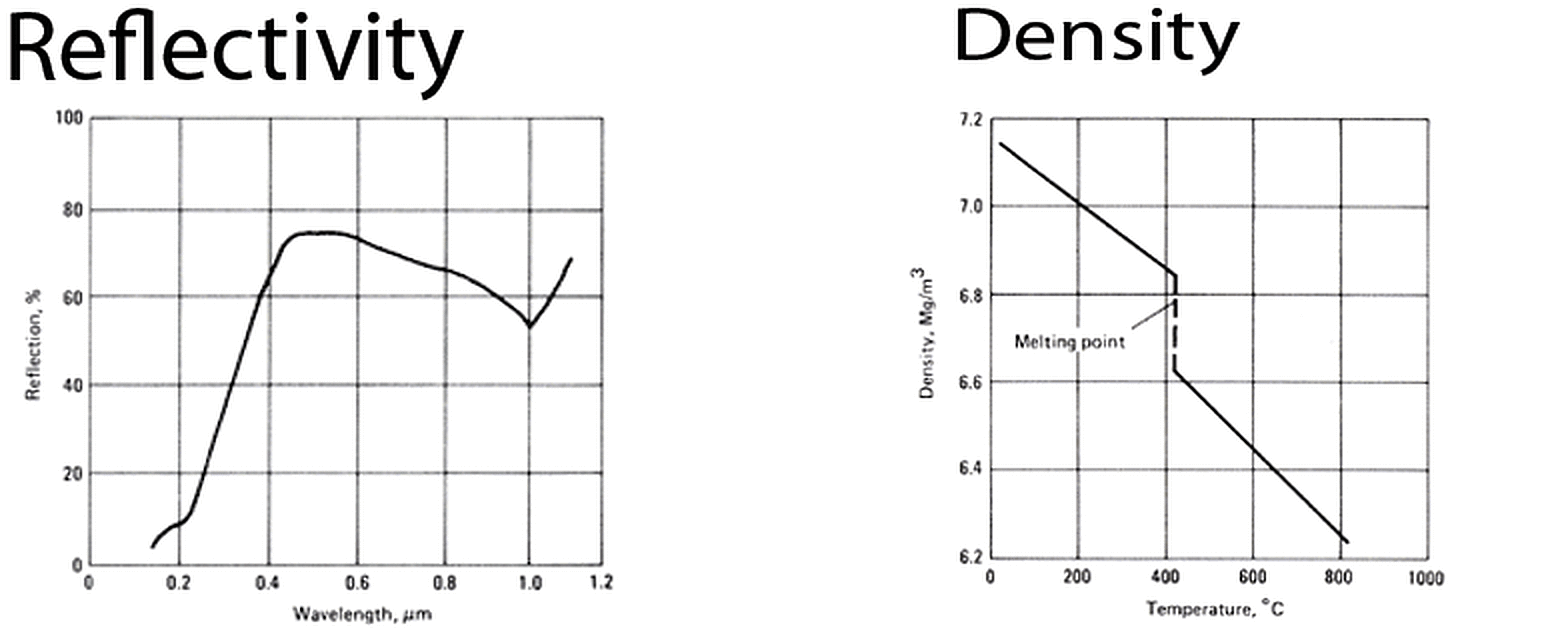Zinc Metal Properties
Physical and Mechanical Properties
| Tensile Strength | |
|---|---|
| (cast) | 28 MN/m2 (4,000 psi) |
| (rolled, with grain) | 126 MN/m2 (18,000 psi) 246 MN/m2 (35,000 psi) |
| Elongation (rolled, with grain) | |
| (99.95% zinc soft temper) | 65% |
| (98.0% zinc hard temper) | 5% |
| Modulus of elasticity | 7 x 104 MN/m2 (1 x 107 psi) |
| Brinell hardness, 500 kg load for 30 sec. | 30 |
| Impact resistance | |
| (pressed zinc, elongation = 30%) | 6.5-9 J/cm2 (26-35 ft-lbs/in2) |
| Surface tension, liquid (4500C) | 0.755 N/m |
| Surface tension, liquid (419.50C) | 0.782 N/m |
| Viscosity, liquid (419.50C) | 0.00385 N/m |
| Coefficient of friction (rolled zinc vs rolled zinc) | 0.21 |
| Density | See chart below |
| Hardness | 2.5 mohs |
| Surface Reflectivity | See chart below |

Thermal Properties
| Thermal | |
|---|---|
| Melting point | 419.5C (787.1F) |
| Boiling point (760 mm Hg) | 907C (1664.6F) |
| Combustion temperature | 1800C (approx, 3272F) |
| Vapor pressure | (419.5C) 1.39 x 10-1 mm Hg |
| Thermal Conductivity | |
| solid (18C) | 113 W/m.K |
| solid (410.5C) | 96 W/m.K |
| liquid (419.5C) | 164 W/m.K |
| liquid (750C) | 57 W/m.K |
| Linear coefficient of thermal expansion | |
| (single crystal along a axis 0-100C) | 15 mm/ m.K |
| (single crystal along c axis 0-100C) | 61 mm/ m.K |
| (polycrystalline 20-250C) | 61 mm/ m.K |
| Volume coefficient of thermal expansion | |
| (20-400C) | 0.89 x 10-6/K |
| (120-360C) | 0.85 x 10-6/K |
| Contraction on freezing at 419.5C | 4.48% |
| Volume change on freezing 46 C -> 0C | 7.28% |
| Specific heat (20C) | 0.382 kJ/kg.K |
| Latent heat of fusion (419.5C) | 100.9 kJ/kg |
| Latent heat of vaporization (906C) | 1.782 MJ/kg |
| Heat capacity | |
| solid | Cp = 22.40 +10.5 x 10-3 Tjmol-1 (298-692.7 K) |
| liquid | Cp = 31.40 Jmol-1 |
| gas | Cp = 20.80 Jmol-1 |
Other Uses of Zinc

